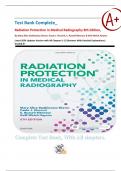Test Bank Complete_
Radiation Protection in Medical Radiography 8th Edition,
By Mary Alice Statkiewicz Sherer, Paula J. Visconti, E. Russell Ritenour & Kelli Welch Haynes
Latest 2024 Updates Version with All Chapters 1-15|Answers With Detailed Explanations|
Graded A+
,Table of Contents
Chapter 01: Introduction To Radiation Protection ....................................................................................... 3
Chapter 02: Radiation: Types, Sources, And Doses Received ..................................................................... 17
Chapter 03: Interaction Of X-Radiation With Matter ................................................................................. 30
Chapter 04: Radiation Quantities And Units............................................................................................... 43
Chapter 05: Radiation Monitoring .............................................................................................................. 58
Chapter 06: Overview Of Cell Biology ......................................................................................................... 73
Chapter 07: Molecular And Cellular Radiation Biology............................................................................... 86
Chapter 08: Early Tissue Reactions And Their Effects On Organ Systems ................................................ 101
Chapter 09: Stochastic Effects And Late Tissue Reactions Of Radiation In Organ Systems ..................... 115
Chapter 10: Dose Limits For Exposure To Ionizing Radiation ................................................................... 129
Chapter 11: Equipment Design For Radiation Protection......................................................................... 144
Chapter 12: Management Of Patient Radiation Dose During Diagnostic X-Ray Procedures ................... 158
Chapter 13. Special Consideration On Radiation Safety In Computed Tomography And Mammography
.................................................................................................................................................................. 173
Chapter 14: Management Of Imaging Personnel Radiation Dose During Diagnostic X-Ray Procedures . 186
Chapter 15: Radioisotopes And Radiation Protection .............................................................................. 200
,Chapter 01: Introduction To Radiation Protection
Statkiewicz Sherer: Radiation Protection In Medical Radiography 8th Edition Test Bank
MULTIPLE CHOICE
1. Consequences Of Ionization In Human Cells Include:
1.Creation Of Unstable Atoms.
2. Production Of Free Electrons.
3. Creation Of Highly Reactive Free Radicals Capable Of Producing Substances
Poisonous To The Cell.
4. Creation Of New Biologic Molecules Detrimental To The Living Cell.
5. Injury To The Cell That May Manifest Itself As Abnormal Function Or Loss Of
Function.
A. 1, 2, And 3 Only
B. 2, 3, And 4 Only
C. 3, 4, And 5 Only
D. 1, 2, 3, 4, And 5
ANS: D
Ionization Causes A Cascade Of Effects That Include Unstable Atoms, Free Electrons,
And Free Radicals, All Of Which Can Lead To Biochemical Changes Detrimental To
The Cell's Normal Function. These Reactions May Result In The Formation Of Toxic
Substances And Cause Injury To The Cell, Possibly Impairing Its Function Or Even
Killing It.
REF: P.2
,2. Which Of The Following Is A Form Of Radiation That Is Capable Of Creating
Electrically Charged Particles By Removing Orbital Electrons From The Atom Of
Normal Matter Through Which It Passes?
A. Ionizing Radiation
B. Nonionizing Radiation
C. Subatomic Radiation
D. Ultrasonic Radiation
ANS: A
Ionizing Radiation Has Enough Energy To Remove Electrons From Atoms, Creating
Charged Particles (Ions). This Includes Types Of Radiation Like X-Rays And Gamma
Rays. Nonionizing Radiation, By Contrast, Does Not Have Sufficient Energy To Ionize
Atoms.
REF: P.2
3. Regarding Exposure To Ionizing Radiation, Patients Who Are Educated To
Understand The Medical Benefit Of An Imaging Procedure Are More Likely To:
A. Assume A Small Chance Of Biologic Damage But Not Suppress Any Radiation
Phobia They May Have.
B. Cancel Their Scheduled Procedure Because They Are Not Willing To Assume A
Small Chance Of Biologic Damage.
C. Suppress Any Radiation Phobia But Not Risk A Small Chance Of Possible Biologic
Damage.
D. Suppress Any Radiation Phobia And Be Willing To Assume A Small Chance Of
Possible Biologic Damage.
ANS: D
When Patients Are Well-Informed About The Benefits Of Medical Imaging Procedures,
They Are More Likely To Make Informed Decisions And Accept A Small Risk Of
,Biologic Damage. Education Helps Alleviate Concerns And Allows Them To Balance
Potential Harm With The Benefit Of The Procedure.
REF: P.8
4. The Millisievert (Msv) Is Equal To:
A. 1/10 Of A Sievert
B. 1/100 Of A Sievert
C. 1/1000 Of A Sievert
D. 1/10,000 Of A Sievert
ANS: C
The Millisievert (Msv) Is A Metric Unit Used To Measure Radiation Dose, And It Is
1/1000 Of A Sievert (Sv), Which Is The Si Unit For Measuring The Biological Effect Of
Ionizing Radiation.
REF: P.9
5. The Advantages Of The Bert Method Are:
It Does Not Imply Radiation Risk; It Is Simply A Means For Comparison.
It Emphasizes That Radiation Is An Innate Part Of Our Environment.
It Provides An Answer That Is Easy For The Patient To Comprehend.
A. 1 And 2 Only
B. 1 And 3 Only
C. 2 And 3 Only
D. 1, 2, And 3
ANS: D
The Bert (Background Equivalent Radiation Time) Method Allows For Easy
Communication Of Radiation Exposure By Comparing It To The Natural Background
Radiation That People Are Already Exposed To In Their Daily Lives. It Emphasizes That
, Radiation Is A Normal Part Of The Environment And Is A Simple Way To Educate
Patients Without Creating Unnecessary Fear.
REF: P.9
6. If A Patient Asks A Radiographer A Question About How Much Radiation He Or She
Will Receive From A Specific X-Ray Procedure, The Radiographer Can:
A. Respond By Using An Estimation Based On The Comparison Of Radiation Received
From The X-Ray To Natural Background Radiation Received.
B. Avoid The Patient’s Question By Changing The Subject.
C. Tell The Patient That It Is Unethical To Discuss Such Concerns.
D. Refuse To Answer The Question And Recommend That He Or She Speak With The
Referring Physician.
ANS: A
Radiographers Can Provide Patients With An Informed Estimate Of Radiation Dose
Based On Comparisons To Background Radiation. This Helps Address Patient Concerns
While Also Educating Them About The Safety Of The Procedure.
REF: P.9
7. Why Should The Selection Of Technical Exposure Factors For All Medical Imaging
Procedures Always Follow ALARA?
A. So That Referring Physicians Ordering Imaging Procedures Do Not Have To Accept
Responsibility For Patient Radiation Safety.
B. So That Radiographers And Radiologists Do Not Have To Accept Responsibility For
Patient Radiation Safety.
C. Because Radiation-Induced Cancer Does Not Appear To Have A Dose Level Below
Which Individuals Would Have No Chance Of Developing This Disease.
D. Because Radiation-Induced Cancer Does Have A Dose Level At Which Individuals
Would Have A Chance Of Developing This Disease.




